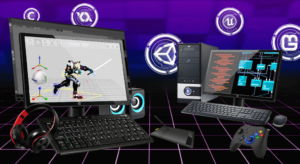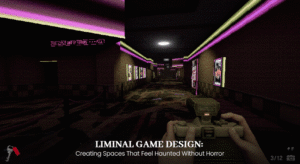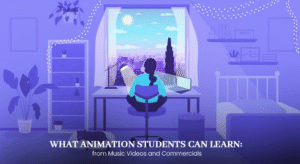
The Importance of User Experience (UX) in Real-Time 3D Design
Real-time 3D design transforms our relationship with technology in the emerging digital environment through the creation of exciting settings for virtual reality, video games, and architectural visualizations. Its impact is indisputable, drawing people in with its realistic and interactive elements. Real-time 3D design is magical in ways that go beyond aesthetics. The secret to genuinely captivating experiences is User Experience (UX), which is all about making user interactions with digital interfaces smooth, easy to use, and delightful. In real-time 3D design, outstanding UX turns a decent design into an exceptional one. In this article, we’ll learn, how UX principles enhance user satisfaction, engagement, and overall experience in 3D environments.
What is Real-Time 3D Design?
Definition
Real-time 3D design generates dynamic digital environments that respond immediately to human interaction. Real-time 3D enables for dynamic editing of 3D objects and scenes, in contrast to static pre-rendered visuals. Examples include video games that allow players to explore immersive worlds, as well as virtual reality (VR), which provides lifelike simulations. Architectural visualization uses real-time 3D to produce interactive walkthroughs of structures, allowing for visualization before the construction of the original one.
Technological Advancements
Real-time 3D design has become more powerful and accessible with the recent advances in technology. High-performance GPUs produce complex scenes with clarity and fluidity, while tools like Unreal Engine and Unity give a strong foundation for developing sophisticated apps. Affordable VR headsets have made these encounters more accessible, while improvements in AI and machine learning are helping to create more intuitive and responsive 3D worlds.
What is User Experience (UX)?
User Experience (UX) in digital design refers to how users perceive and interact with a digital product or service. It includes usability, ensuring tasks are intuitive and efficient; accessibility, making the product usable by all, including those with disabilities; engagement, fostering user interest and interaction through compelling design elements; and satisfaction, eliciting positive emotional responses by meeting user needs and expectations. UX design aims to create meaningful and enjoyable experiences across websites, applications, and interactive environments, emphasizing ease of use, inclusivity, user engagement, and overall satisfaction to enhance the interaction between users and digital interfaces.
The Intersection of UX and Real-Time 3D Design
In real-time 3D design, User Experience (UX) holds crucial importance for creating intuitive and immersive digital environments. Unlike 2D interfaces, 3D spaces demand seamless navigation and responsive interactions to meet user expectations of realism and usability. Effective UX design ensures that users can effortlessly engage with virtual worlds, enhancing satisfaction and productivity. Whether in video games, architectural visualization, or virtual reality, integrating UX principles like intuitive navigation and interactive feedback is essential. This approach not only improves usability but also shapes how users perceive and interact with digital experiences, making UX a cornerstone of modern real-time 3D design practices.
Key Elements of Effective UX in Real-Time 3D Design
Effective User Experience (UX) in real-time 3D design hinges on several key elements that directly impact user satisfaction and engagement.
Usability
- Crucial for navigating and interacting within 3-D environments.
- Examples: Intuitive controls in games vs. complex interfaces causing frustration.
Interactivity
- Enhances user engagement by allowing active participation.
- Example: Architectural walkthroughs enabling dynamic exploration.
immersiveness
- Key to creating realistic or fantastical experiences in 3D design.
- Example: Simulating real-life scenarios to draw users into the environment.
Feedback Mechanisms
- Provide real-time information on user actions.
- Ensure users feel in control and enhance realism.
- Examples: Visual cues, and haptic responses in virtual environments.
Challenges in Implementing UX in Real-Time 3D Design
Implementing User Experience (UX) in real-time 3D design poses several significant challenges that designers must navigate:
Technical Limitations
Designers often encounter technical hurdles when applying UX principles in real-time 3D environments. These challenges include optimizing graphics rendering, managing data streaming for large-scale virtual worlds, and ensuring smooth interactions without compromising performance.
Complexity of Design
Creating user-friendly interfaces in 3D spaces is inherently complex. Designers must balance aesthetics with functionality, considering factors like spatial navigation, control schemes, and the integration of interactive elements. Simplifying complex interactions while maintaining usability is a constant challenge.
Balancing Performance and UX
There’s a delicate balance between optimizing performance and delivering a compelling user experience. Design decisions such as texture resolution, polygon count, and real-time physics simulations impact both visual fidelity and responsiveness. Achieving seamless interactions while upholding visual quality requires iterative testing and refinement.
Best Practices for Enhancing UX in Real-Time 3D Design
Enhancing User Experience (UX) in real-time 3D design involves adopting several best practices to ensure intuitive and engaging interactions:
User Research
Understanding user needs and behaviours is foundational. Conducting thorough research helps in designing interfaces that cater to user expectations and preferences within 3D environments. By gathering insights into how users interact with similar applications or games, designers can prioritize features and functionalities that enhance usability and satisfaction.
Prototyping and Testing
Iterative design processes are crucial. Prototyping allows designers to create interactive mock-ups of their 3D environments, which can then be tested with real users. Gathering feedback early and often helps identify usability issues, refine interface elements, and optimize user flows. This approach ensures that the final product aligns closely with user expectations and improves overall UX.
Cross-Disciplinary Collaboration
Collaboration between UX designers, developers, and 3D artists is essential for holistic design solutions. Each discipline brings unique insights and skills to the table, contributing to cohesive experiences that seamlessly blend visual appeal with usability. By fostering open communication and sharing expertise across teams, designers can address complex challenges more effectively and deliver cohesive user experiences.
Continuous Improvement
UX design in real-time 3D is iterative. Emphasizing continuous improvement allows designers to evolve their designs based on user feedback, technological advancements, and industry trends. Regular updates and refinements ensure that the application remains relevant, engaging, and user-friendly over time.
Conclusion
Prioritizing User Experience (UX) in real-time 3D design is essential for developing compelling and user-friendly apps. Through prioritizing usability, interaction, and immersiveness, designers guarantee that their products not only perform flawlessly but also offer a delightful and easy-to-use interface. Apply UX concepts to improve user pleasure and project success in gaming, virtual reality, and architectural visualization. Explore professional development opportunities at Arena Animations on Park Street to improve your UX design skills. Please share your ideas or concerns regarding UX in 3D design in the comments section below as we collaborate to raise user experience standards in 3D environments.












